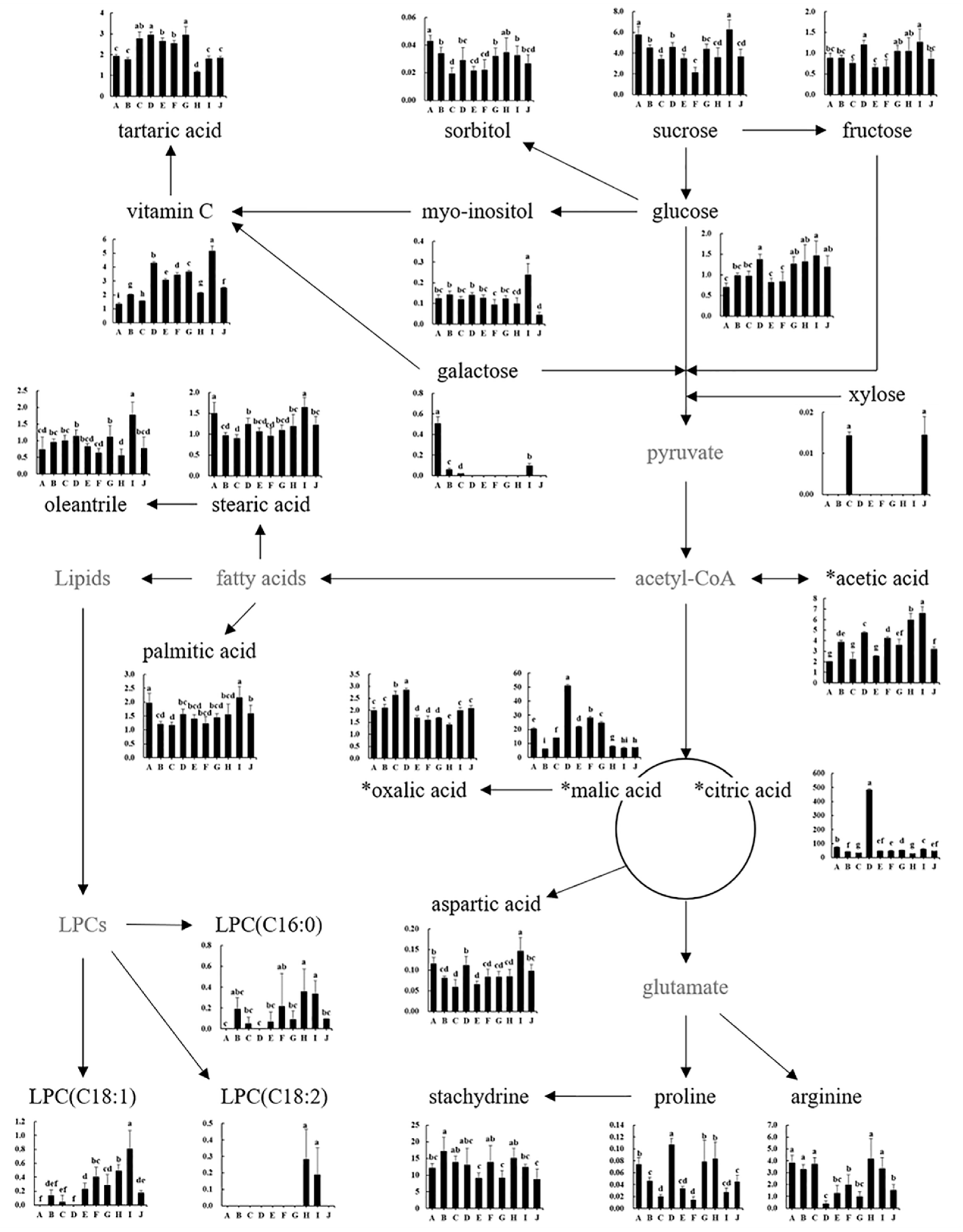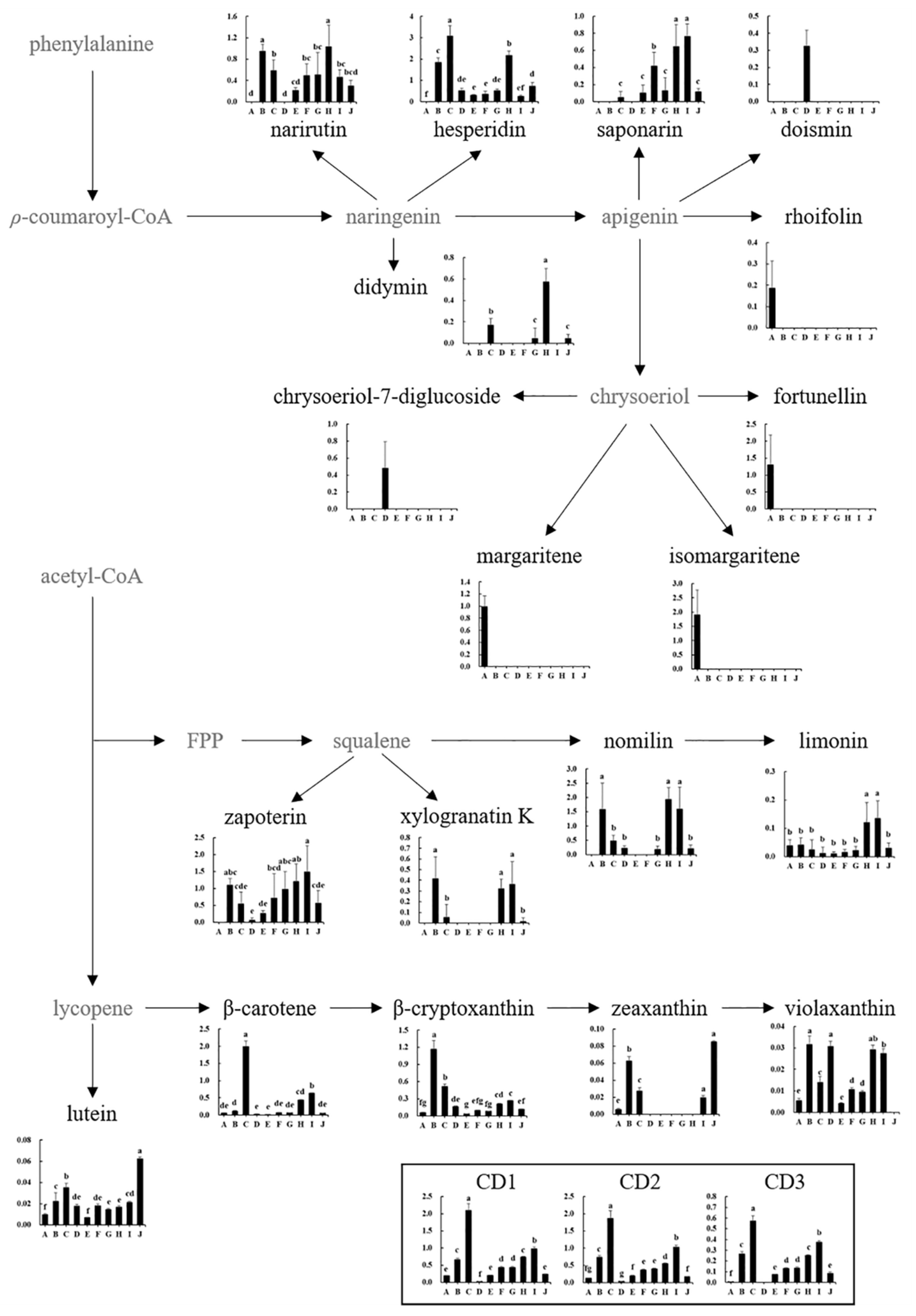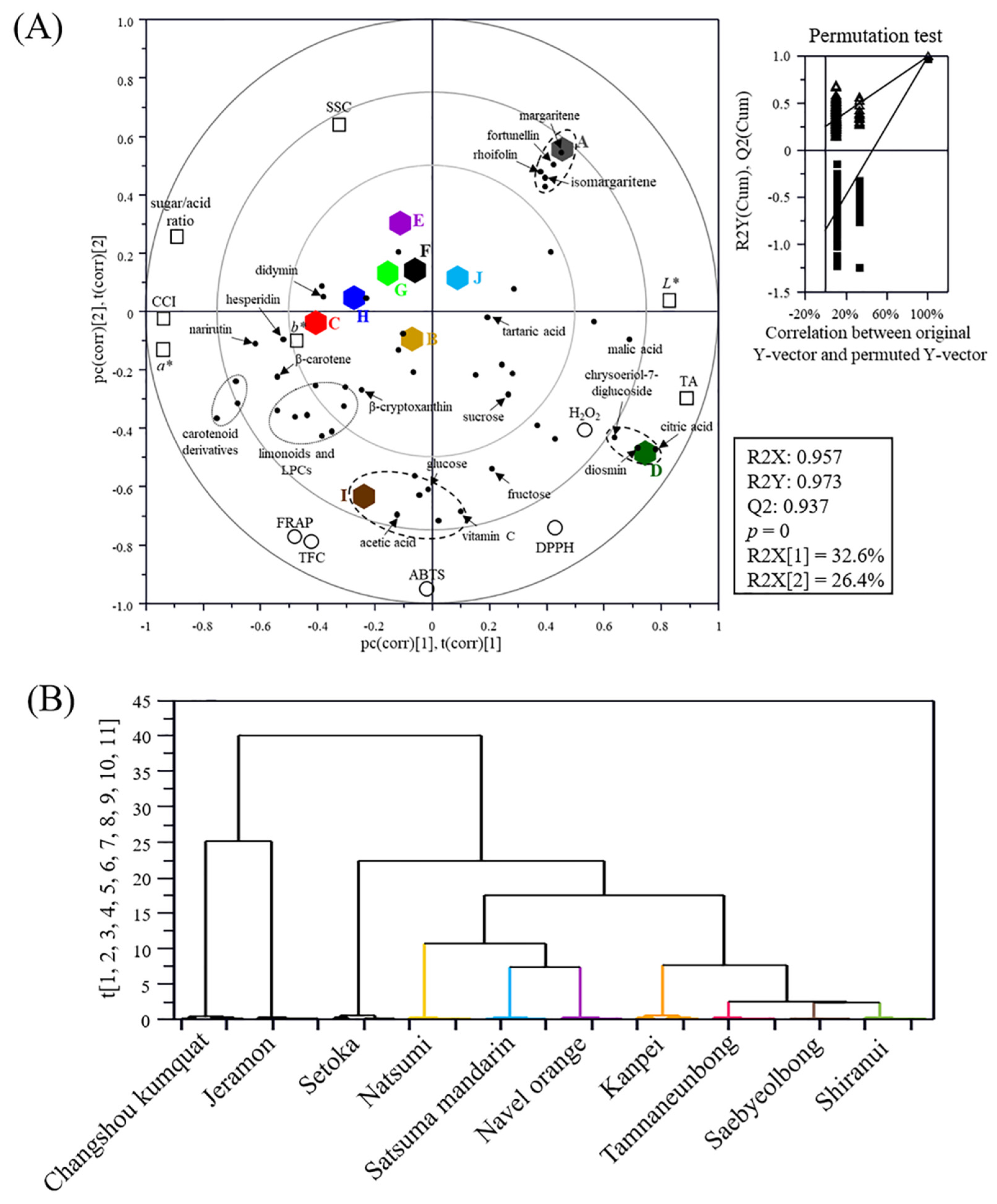Comparative Metabolomics Analysis of Citrus Varieties
Abstract
:1. Introduction
2. Materials and Methods
2.1. Citrus Samples
2.2. Color, SSC, pH, and TA
2.3. TFC and Antioxidant Activity
2.4. Analysis of Metabolites Using GC-MS
2.5. Analysis of Metabolites Using UPLC-QTOF-MS
2.6. Analysis of Organic Acids, Vitamin C, and Carotenoids Using HPLC
2.7. Statistical Analysis
3. Results and Discussion
3.1. Characteristics of Citrus Varieties
3.2. TFC and Antioxidant Activity
3.3. Metabolomic Analysis
3.4. Identification of Major Metabolites
3.5. Metabolic Pathway and Relative Abundance of Identified Metabolites
3.6. Correlation between Quality Characteristics, Metabolites, and Citrus Varieties
3.7. Classification of Citrus Varieties
4. Conclusions
Supplementary Materials
Author Contributions
Funding
Institutional Review Board Statement
Informed Consent Statement
Data Availability Statement
Conflicts of Interest
References
- Tunis, R.; Loizzo, M.R.; Menichini, F. An overview on chemical aspects and potential health benefits of limonoids and their derivatives. Crit. Rev. Food Sci. Nutr. 2014, 54, 225–250. [Google Scholar] [CrossRef]
- Stinco, C.M.; Escudero-Gilete, M.L.; Heredia, F.J.; Vicario, I.M.; Meléndez-Martínez, A.J. Multivariate analyses of a wide selection of orange varieties based on carotenoid contents, color and in vitro antioxidant capacity. Food. Res. Int. 2016, 90, 194–204. [Google Scholar] [CrossRef]
- Lado, J.; Gambetta, G.; Zacarias, L. Key determinants of citrus fruit quality: Metabolites and main changes during maturation. Sci. Hortic. 2018, 233, 238–248. [Google Scholar] [CrossRef] [Green Version]
- Gabriele, M.; Frassinetti, S.; Caltavuturo, L.; Montero, L.; Dinelli, G.; Longo, V.; Gioia, D.D.; Pucci, L. Citrus bergamia powder: Antioxidant, antimicrobial and anti-inflammatory properties. J. Funct. Foods 2017, 31, 255–265. [Google Scholar] [CrossRef]
- Rafiq, S.; Kaul, R.; Sofi, S.S.; Bashir, N.; Nazir, F.; Nayik, G.A. Citrus peel as a source of functional ingredient: A review. J. Saudi Soc. Agric. Sci. 2018, 17, 351–358. [Google Scholar] [CrossRef] [Green Version]
- Kimura, Y.; Naeshiro, M.; Tominaga, Y.; Anai, T.; Komai, F. Metabolite composition of grapefruit (Citrus paradisi) grown in japan depends on the growing environment and harvest period. Hortic. J. 2017, 86, 543–551. [Google Scholar] [CrossRef] [Green Version]
- Zhao, X.J.; Xing, T.T.; Li, Y.F.; Jiao, B.N. Analysis of phytochemical contributors to antioxidant capacity of the peel of Chinese mandarin and orange varieties. Int. J. Food Sci. Nutr. 2019, 70, 825–833. [Google Scholar] [CrossRef] [PubMed]
- Ollitrault, P.; Navarro, L. Citrus. In Fruit Breeding, Handbook of Plant Breeding; Badenes, M.L., Byrne, D.H., Eds.; Springer: New York, NY, USA, 2012; p. 626. [Google Scholar] [CrossRef]
- Salonia, F.; Ciacciulli, A.; Poles, L.; Pappalardo, H.D.; Malfa, S.L.; Licciardello, C. New Plant breeding techniques in citrus for the improvement of important agronomic traits. A Review. Front. Plant Sci. 2020, 11, 1234. [Google Scholar] [CrossRef] [PubMed]
- Wu, G.A.; Terol, J.; Ibanez, V.; López-García, A.; Pérez-Román, E.; Borredá, C.; Domingo, C.; Tadeo, F.R.; Carbonell-Caballero, J.; Alonso, R.; et al. Genomics of the origin and evolution of Citrus. Nature 2018, 554, 311–316. [Google Scholar] [CrossRef] [PubMed] [Green Version]
- Dória, M.S.; Guedes, M.S.; de Andrade Silva, E.M.; Oliveira, T.M.; Pirovani, C.P.; Kupper, K.C.; Bastianel, M.; Micheli, F. Comparative proteomics of two citrus varieties in response to infection by the fungus Alternaria alternata. Int. J. Biol. Macromol. 2019, 136, 410–423. [Google Scholar] [CrossRef]
- Duan, L.; Guo, L.; Dou, L.L.; Zhou, C.L.; Xu, F.G.; Zheng, G.D.; Li, P.; Liu, E.H. Discrimination of Citrus reticulata Blanco and Citrus reticulata ‘Chachi’ by gas chromatograph-mass spectrometry based metabolomics approach. Food Chem. 2016, 212, 123–127. [Google Scholar] [CrossRef]
- Nonaka, K.; Fujii, H.; Kita, M.; Shimada, T.; Endo, T.; Yoshioka, T.; Omura, M. Identification and parentage analysis of citrus cultivars developed in Japan by CAPS markers. Hortic. J. 2017, 86, 208–221. [Google Scholar] [CrossRef] [Green Version]
- Lado, J.; Rodrigo, M.J.; Zacarias, L. Maturity indicators and citrus fruit quality. Stewart Postharvest Rev. 2014, 2, 1–6. [Google Scholar]
- Pękal, A.; Pyrzynska, K. Evaluation of aluminium complexation reaction for flavonoid content assay. Food Anal. Methods 2014, 7, 1776–1782. [Google Scholar] [CrossRef] [Green Version]
- Blois, M.S. Antioxidant determinations by use of a stable free radical. Nature 1958, 181, 1199–1200. [Google Scholar] [CrossRef]
- Re, R.; Pellegrini, N.; Proteggente, A.; Pannala, A.; Yang, M.; Rive-Evans, C. Antioxidant activity applying an improved ABTS radical cation decolorization assay. Free Radic. Biol. Med. 1999, 26, 1231–1237. [Google Scholar] [CrossRef]
- Benzie, I.F.F.; Strain, J.J. The ferric reducing ability of plasma (FRAP) as a measure of ‘‘antioxidant power’’: The FRAP Assay. Anal. Biochem. 1996, 239, 70–76. [Google Scholar] [CrossRef] [Green Version]
- Wettasinghe, M.; Shahidi, F. Scavenging of reactive-oxygen species and DPPH free radicals by extracts of borage and evening primrose meals. Food Chem. 2000, 70, 17–26. [Google Scholar] [CrossRef]
- Kim, H.; Kim, O.W.; Ahn, J.H.; Kim, B.M.; Oh, J.; Kim, H.J. Metabolomic analysis of germinated brown rice at different germination stages. Foods 2020, 9, 1130. [Google Scholar] [CrossRef]
- Delgado, T.; Ramalhosa, E.; Pereira, J.A.; Casal, S. Organic acid profile of chestnut (Castanea sativa Mill.) as affected by hot air convective drying: Drying influence on chestnut organic acids. Int. J. Food Prop. 2018, 21, 557–565. [Google Scholar] [CrossRef] [Green Version]
- Matsumoto, H.; Ikoma, Y.; Kato, M.; Kuniga, T.; Nakajima, N.; Yoshida, T. Quantification of carotenoids in citrus fruit by LC-MS and comparison of patterns of seasonal changes for carotenoids among citrus varieties. J. Agric. Food Chem. 2007, 55, 2356–2368. [Google Scholar] [CrossRef]
- Petry, F.C.; Nadai, F.B.; Cristofani-Yaly, M.; Latado, R.R.; Mercadante, A.Z. Carotenoid biosynthesis and quality characteristics of new hybrids between tangor (Citrus reticulata × C. sinensis) cv. ‘Murcott’ and sweet orange (C. sinensis) cv. ‘Pera’. Food Res. Int. 2019, 122, 461–470. [Google Scholar] [CrossRef]
- Zheng, X.; Tang, Y.; Ye, J.; Pan, Z.; Tan, M.; Xie, Z.; Chai, L.; Xu, Q.; Fraser, P.D.; Deng, X. SLAF-based construction of a high-density genetic map and its application in QTL mapping of carotenoids content in citrus fruit. J. Agric. Food Chem. 2019, 67, 994–1002. [Google Scholar] [CrossRef] [PubMed]
- Hussain, S.; Shi, C.Y.; Guo, L.X.; Kamran, H.M.; Sadka, A.; Liu, Y.Z. Recent advances in the regulation of citric acid metabolism in citrus fruit. Crit. Rev. Plant Sci. 2017, 36, 241–256. [Google Scholar] [CrossRef]
- Sadka, A.; Shlizerman, L.; Kamara, I.; Blumwald, E. Primary metabolism in citrus fruit as affected by its unique structure. Front. Plant Sci. 2019, 10, 1167. [Google Scholar] [CrossRef] [PubMed]
- Assefa, A.D.; Saini, R.K.; Keum, Y.S. Fatty acids, tocopherols, phenolic and antioxidant properties of six citrus fruit species: A comparative study. J. Food. Meas. Charact. 2017, 11, 1665–1675. [Google Scholar] [CrossRef]
- Smirnoff, N. Ascorbic acid metabolism and functions: A comparison of plants and mammals. Free Radic. Biol. Med. 2018, 122, 116–129. [Google Scholar] [CrossRef]
- Nabi, F.; Arain, M.A.; Rajput, N.; Alagawany, M.; Soomro, J.; Umer, M.; Soomro, F.; Wang, Z.; Ye, R.; Liu, J. Health benefits of carotenoids and potential application in poultry industry: A review. J. Anim. Physiol. Anim. Nutr. 2020, 104, 1809–1818. [Google Scholar] [CrossRef] [PubMed]
- Benavente-Garcia, O.; Castillo, J.; Marin, F.R.; Ortuno, A.; Rio, J.A.D. Uses and properties of citrus flavonoids. J. Agric. Food Chem. 1997, 45, 4505–4515. [Google Scholar] [CrossRef]
- Roland, W.S.U.; Buren, L.; Gruppen, H.; Driesse, M.; Gouka, R.J.; Smit, G.; Vincken, J.P. Bitter taste receptor activation by flavonoids and isoflavonoids: Modeled structural requirements for activation of hTAS2R14 and hTAS2R39. J. Agric. Food Chem. 2013, 61, 10454–10466. [Google Scholar] [CrossRef]
- Shin, W.; Kim, S.J.; Shin, J.M. Structure-taste correlations in sweet dihydrochalcone, sweet dihydroisocoumarin, and bitter flavone compounds. J. Med. Chem. 1995, 38, 4325–4331. [Google Scholar] [CrossRef] [PubMed]
- Frydman, A.; Weisshaus, O.; Bar-Peled, M.; Huhman, D.V.; Sumner, L.W.; Marin, F.R.; Lewinsohn, E.; Fluhr, R.; Gressel, J.; Eyal, Y. Citrus fruit bitter flavors: Isolation and functional characterization of the gene Cm1,2RhaT encoding a 1,2 rhamnosyltransferase, a key enzyme in the biosynthesis of the bitter flavonoids of citrus. Plant J. 2004, 40, 88–100. [Google Scholar] [CrossRef]
- Alexander, L.; Beer, D.; Muller, M.; Rijst, M.; Joubert, E. Potential of benzophenones and flavanones to modulate the bitter intensity of Cyclopia genistoides herbal tea. Food Res. Int. 2019, 125, 108519. [Google Scholar] [CrossRef] [PubMed]
- Huang, J.; Lu, Y.J.; Guo, C.; Zuo, S.; Zhou, J.L.; Wong, W.L.; Huang, B. The study of citrus-derived flavonoids as effective bitter taste inhibitors. J. Sci. Food Agric. 2021, 101, 5163–5171. [Google Scholar] [CrossRef] [PubMed]
- Glabasnia, A.; Dunkel, A.; Frank, O.; Hofmann, T. Decoding the nonvolatile sensometabolome of orange juice (Citrus sinensis). J. Agric. Food Chem. 2018, 66, 2354–2369. [Google Scholar] [CrossRef]
- Fanciullino, A.L.; Cercos, M.; Dhuique-Mayer, C.; Froelicher, Y.; Talon, M.; Ollitrault, P.; Morillon, R. Changes in carotenoid content and biosynthetic gene expression in juice sacs of four orange varieties (Citrus sinensis) differing in flesh fruit color. J. Agric. Food Chem. 2008, 56, 3628–3638. [Google Scholar] [CrossRef]
- Mesbahi, G.; Jamalian, J.; Farahnaky, A. A comparative study on functional properties of beet and citrus pectins in food systems. Food Hydrocoll. 2005, 19, 731–738. [Google Scholar] [CrossRef]
- Yoo, K.M.; Lee, K.W.; Park, J.B.; Lee, H.J.; Hwang, I.K. Variation in major antioxidants and total antioxidant activity of yuzu (Citrus junos Sieb ex Tanaka) during maturation and between cultivars. J. Agric. Food Chem. 2004, 52, 5907–5913. [Google Scholar] [CrossRef]
- M’hiri, N.; Irina, I.; Cédric, P.; Ghoul, M.; Boudhrioua, N. Antioxidant of Maltease orange peel: Comparative investigation of the efficiency of four extraction methods. J. Appl. Pharm. Sci. 2017, 7, 126–135. [Google Scholar] [CrossRef] [Green Version]
- Karmakar, A.; Das, A.K.; Ghosh, S.; Sil, P.C. Carotenoids as Coloring Agents. In Carotenoids: Structure and Function in the Human Body; Zia-Ul-Haq, M., Dewanjee, S., Riaz, M., Eds.; Springer: Cham, Switzerland, 2021; pp. 27, 191. [Google Scholar]





| L* | a* | b* | CCI | SSC (°Brix) | pH | TA (%) | SSC/TA Ratio | TFC (mg NAR/g DM) | Antioxidant Activity (mg TE/g DM) | ||||
|---|---|---|---|---|---|---|---|---|---|---|---|---|---|
| DPPH | ABTS | FRAP | H2O2 | ||||||||||
| Changshou kumquat | 86.62 a | −1.29 i | 30.21 f | −0.49 i | 20.14 a | 3.85 bc | 2.12 c | 9.53 f | 3.27 g | 2.44 c | 2.32 e | 2.11 e | 45.62 b |
| Satsuma mandarin | 75.58 c | 12.01 d | 47.84 a | 3.32 g | 11.16 e | 4.22 bcd | 0.96 e | 11.64 e | 4.73 bc | 2.04 e | 3.82 cd | 4.99 bc | 53.50 a |
| Natsumi | 50.82 h | 18.45 a | 42.41 b | 8.57 a | 12.38 d | 3.88 bcd | 0.77 f | 16.00 b | 4.89 b | 2.19 d | 4.00 c | 4.65 d | 43.34 c |
| Jeramon | 80.38 b | −3.74 j | 25.17 h | −1.85 j | 7.24 f | 4.05 f | 5.06 a | 1.43 h | 4.36 d | 3.99 a | 5.54 b | 4.65 d | 54.73 a |
| Saebyeolbong | 54.36 g | 8.22 f | 32.21 e | 4.70 e | 18.32 b | 3.80 e | 1.28 d | 14.31 c | 3.53 f | 2.40 c | 3.64 d | 4.81 bcd | 29.58 g |
| Tamnaneunbong | 54.95 g | 6.84 g | 29.57 f | 4.21 f | 19.06 b | 3.70 de | 1.66 c | 11.50 e | 4.26 d | 2.37 c | 3.86 cd | 4.73 cd | 38.68 e |
| Shiranui | 54.17 g | 14.39 b | 34.27 d | 7.75 b | 19.12 b | 3.67 de | 1.60 c | 11.93 de | 3.83 e | 2.60 b | 3.82 cd | 5.06 b | 36.82 f |
| Kanpei | 57.55 f | 10.26 e | 28.70 g | 6.21 c | 18.24 b | 3.69 ab | 1.01 e | 18.07 a | 4.48 cd | 2.15 de | 4.11 c | 5.06 b | 40.46 d |
| Setoka | 59.61 e | 12.87 c | 37.82 c | 5.71 d | 16.48 c | 3.59 cd | 1.28 d | 12.85 d | 5.18 a | 3.93 a | 6.12 a | 8.15 a | 42.23 c |
| Navel orange | 65.06 d | 4.47 h | 42.71 b | 1.61 h | 17.14 c | 3.91 a | 2.05 b | 8.36 g | 3.94 e | 2.21 d | 3.84 cd | 4.85 bcd | 46.47 b |
Publisher’s Note: MDPI stays neutral with regard to jurisdictional claims in published maps and institutional affiliations. |
© 2021 by the authors. Licensee MDPI, Basel, Switzerland. This article is an open access article distributed under the terms and conditions of the Creative Commons Attribution (CC BY) license (https://creativecommons.org/licenses/by/4.0/).
Share and Cite
Kim, D.-S.; Lee, S.; Park, S.M.; Yun, S.H.; Gab, H.-S.; Kim, S.S.; Kim, H.-J. Comparative Metabolomics Analysis of Citrus Varieties. Foods 2021, 10, 2826. https://doi.org/10.3390/foods10112826
Kim D-S, Lee S, Park SM, Yun SH, Gab H-S, Kim SS, Kim H-J. Comparative Metabolomics Analysis of Citrus Varieties. Foods. 2021; 10(11):2826. https://doi.org/10.3390/foods10112826
Chicago/Turabian StyleKim, Dong-Shin, Sun Lee, Suk Man Park, Su Hyun Yun, Han-Seung Gab, Sang Suk Kim, and Hyun-Jin Kim. 2021. "Comparative Metabolomics Analysis of Citrus Varieties" Foods 10, no. 11: 2826. https://doi.org/10.3390/foods10112826




